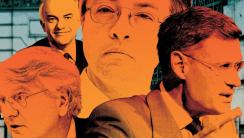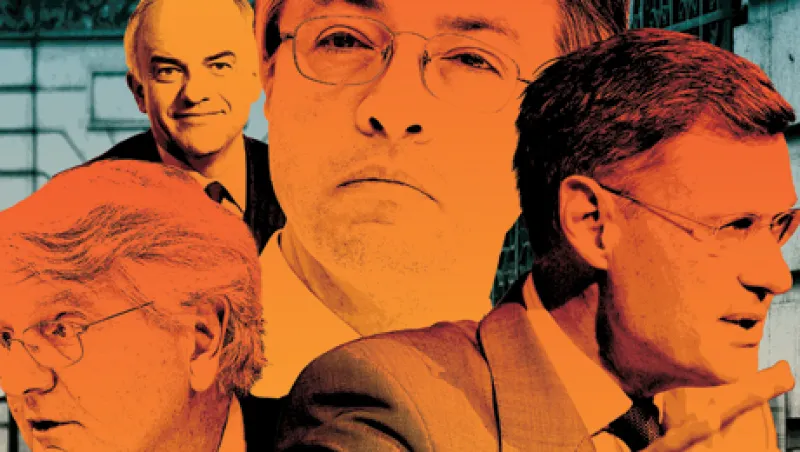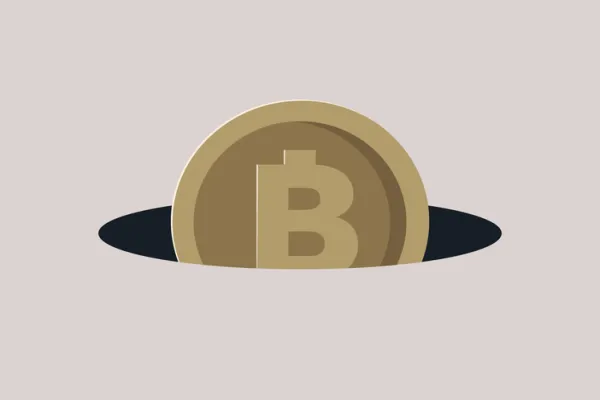JEAN-LAURENT BONNAFÉ SHEDS THE JACKET OF HIS dark-gray suit as he enters the second-floor meeting room of BNP Paribas’s offices at l’Hôtel de Mondragon, a grand former town hall where Napoléon Bonaparte married Joséphine de Beauharnais in 1796. Dressed in a light-blue shirt with a button-down collar and a dark-blue tie, the chief executive officer speaks so softly during a recent interview that it is difficult to hear him above the noise of the Paris traffic outside.
Yet his language is clear enough. In fluent English, he spells out his basic approach to managing the euro zone’s second-largest bank by assets. “As a senior banker, you have to be able to balance the often contrasting themes of risk and innovation, as well as balance a number of different dimensions such as client relationships, technology and staff,” he says. Of BNP, he adds, “we are a balanced company, and that makes it easier for us to survive and prosper across the cycles.”
The big French bank has indeed survived the financial crisis better than most European banks, but its balance poses a serious challenge for Bonnafé. The bulk of the bank’s retail operations, which generate just over half the group’s earnings, are in the heart of the euro zone and are struggling with the economic torpor caused by the bloc’s debt crisis. The French economy has been stagnant with virtually no growth for the past three quarters, while Italy and Belgium, the bank’s other big euro zone markets, have fallen into recession. The corporate and investment banking division (CIB), which usually provides between a quarter and a third of profits, faces pressure to shrink under the weight of tough new capital requirements and other regulations, like much of the investment banking industry. The bank’s investment solutions division, which includes asset management and insurance, is also heavily tied to the European economy and produced flat results in the first half of this year.

As a result, Bonnafé finds himself trying to curb risk and shed assets rather than chase growth, as the bank did with panache for the better part of two decades before the crisis. Bonnafé got a taste of the challenge in the second half of 2011 when fears about a possible Greek default and breakup of the euro roiled the European banking sector. BNP Paribas was hit hard, losing about €100 billion ($128 billion) of short-term funding in the period as U.S. money market funds withdrew, executives say. The unflappable Bonnafé, who was on the front lines as chief operating officer under then-CEO Baudouin Prot, recalls it as “a challenging time.”
In response, Bonnafé and Prot implemented a so-called adaptation plan aimed at deleveraging the bank’s balance sheet. Since September 2011, the bank has slashed risk-weighted assets by 10 percent and sold off much of its holdings of sovereign bonds from peripheral euro zone countries. The bank has also moved more quickly than its peers to raise its core tier-1 capital ratio to 9 percent, which European banking authorities are demanding in order to bolster confidence in the banking sector. BNP Paribas had reached 8.9 percent, under Basel III rules, at the end of June. By contrast, Deutsche Bank expects to achieve a ratio of only 7.2 percent by the end of this year, and Credit Suisse expects to be at 8.6 percent. Even more impressive, BNP Paribas has managed to boost its ratio without issuing fresh capital, something a number of other European banks, including Credit Suisse, UBS and UniCredit, have had to resort to.
BNP Paribas has also maintained profitability even though the deleveraging and weak economy have taken a toll on revenues. The bank reported net income of €4.7 billion in the first six months of 2012, down less than 1 percent from a year earlier, while revenues fell 12 percent, to €20 billion. The results compare favorably with those of most of its rivals. Deutsche’s first-half earnings, for example, fell by a third, to €2.1 billion. BNP Paribas had an enviable record throughout the crisis, in fact: It remained solidly in the black on an annual basis and fell into the red in only one quarter, posting a loss of €1.4 billion in the fourth quarter of 2008. The French bank has always paid a dividend, too, although it did slash its payout by 43 percent earlier this year. By contrast, Deutsche and Credit Suisse posted multibillion-euro losses in 2008.
Investors and analysts have been impressed by BNP Paribas’s response to the euro zone crisis, and, encouraged by the European Central Bank’s efforts to shore up the euro, they have pushed up the share price since August. But many investors remain leery of the bank’s overall profile.
“It’s too much of a euro zone bank,” says Jacques-Pascal Porta, a Paris-based fund manager at OFI Gestion Privée, which holds a small number of shares in BNP Paribas. The bank’s shares were trading at €36.98 on September 28, up 21.8 percent since the end of 2011 but still down 32.7 percent from the start of July 2011, when the euro debt crisis began to heat up. At 7.8 times historic earnings, the stock’s multiple lagged well behind Deutsche’s 10.3 and HSBC Holdings’ 11.
Buying the bank’s shares is often seen as a vote of faith in the euro. Eric Le Coz, deputy managing director of Paris-based asset manager Carmignac Gestion, reports that in August the firm shifted 5 percent of its €28 billion Carmignac Patrimoine diversified fund and its €8 billion Carmignac Investissement equity funds into euro zone banks, including BNP Paribas and Société Générale, because of the ECB’s promise to do “whatever it takes” to defend the euro. Although Carmignac is usually a long-term investor, that might not be the case with bank shares, he says.
To win over investors, Bonnafé, who succeeded Prot as CEO in December, needs to put the group back on the growth track and boost profit margins. That won’t be easy in the current climate. Like most banks, BNP Paribas has suffered a big drop in its return on equity as a result of the crisis, to 8.8 percent in 2011 from 19.6 percent in 2007. The bank managed to boost ROE slightly to 9 percent in the first half, well ahead of the 5.4 percent average ROE of the 11 biggest European banks, but that remains somewhat below its cost of capital.
Investors shouldn’t count on any rapid improvement, the CEO warns. Although the euro zone is on the mend, he expects the economy to remain flat or at best show very sluggish growth for the next two years. “It will be very difficult for a large bank to achieve 10 percent in 2012 and 2013 given the economic environment,” he says. “The 9 percent we’ve achieved so far this year is the best level of any European bank, apart from HSBC.” The London-based bank posted an ROE of 10.5 percent in the first half, with pretax profits up 11 percent at $12.7 billion.
Bonnafé is looking overseas for growth, but progress is likely to be slow and modest at best. The bank is seeking to grow organically in Asia and North America, principally through its CIB and investment solutions divisions. BNP Paribas has slashed its fixed-income trading book, like virtually every other major investment bank, but it is hoping to take advantage of the retrenchment on Wall Street and bolster its fixed-income distribution capabilities in the U.S.
The changes wrought by the crisis make CIB critical to the bank’s future even if the division has to be run with less risk-taking, says Bonnafé. “Corporate and investment banking will become if anything more — not less — important in the coming years,” he says. “Basel III will push Europe closer to the U.S. model of financing in which capital markets, rather than bank lending, supply the bulk of the financing needs of corporations.”
Overall, Bonnafé promises a steady-as-she-goes continuity. The economic and regulatory background rules out much beyond an efficient management of the bank’s existing profile in the near term. Indeed, he doesn’t intend to produce a new business plan for the bank until the end of 2013. As Prot, now chairman, put it in a September interview, “Acquisitions are not a priority now. But our share price is improving, and that potentially makes an acquisition easier.”
BNP Paribas’s management culture also militates against radical change. Bonnafé spent two decades rising through a series of key positions at the bank and served a lengthy apprenticeship under Prot before taking the top job, just as Prot had under his mentor, Michel Pébereau. Executive transitions at BNP Paribas are about as seamless as they come in the banking industry, with predictable results.
“The shape of the business won’t change even after we’ve presented a new business plan at the end of next year,” says Bonnafé. “Our revenues will be half retail, one third corporate and investment banking, one sixth investment solutions.”
The CEO’s vision may lack for excitement, but competent and efficient management of the bank’s sprawling network would be no small achievement under the circumstances.
The health of BNP Paribas has an impact beyond the bank’s customers and shareholders. The bank is a colossus, with €2 trillion in assets at the end of June, almost as much as France’s gross domestic product and second among euro zone banks only to Deutsche’s €2.2 trillion. BNP Paribas is also one of the 29 systemically important financial institutions in the world, as determined by the Basel-based Financial Stability Board. The bank boasts a presence in some 80 countries and a payroll of nearly 200,000 people. No wonder Alain Tchibozo, banks analyst at Mediobanca Securities in London, says that “BNP Paribas is a macro call.”
MOST BANKS ARE PLAYING DEFENSE today, and BNP Paribas is no exception. But the conservative hand that Bonnafé is forced to play is a stark contrast to the relentless growth pursued by his predecessors.
After Banque Nationale de Paris was privatized in 1993, then-CEO Pébereau embarked on a bold expansion effort, building up a big capital markets business with an emphasis on fixed income and equity derivatives and snapping up one of its leading rivals, Paribas, in a bitter three-way battle involving Société Générale in 1999. Prot, who succeeded Pébereau in 2003, accelerated growth by acquiring Italy’s Banca Nazionale del Lavoro in 2006 and building a Central and Eastern Europe franchise, buying up banks in Poland, Turkey and Ukraine.
Ironically, considering how well it came through the crisis, BNP Paribas was a canary in the financial coal mine. The bank’s August 9, 2007, decision to suspend withdrawals on three investment funds with big holdings of U.S. subprime mortgage securities was one of the first signals of the impending turmoil. Later that day, the European Central Bank would inject a then-unprecedented €95 billion in overnight liquidity into the European banking system.
Outside of those investment funds, however, BNP Paribas had relatively little exposure to U.S. mortgage securities, and its losses paled in comparison with those of European banks such as Deutsche, HSBC and UBS. Even its $62 billion-in-assets subsidiary, San Francisco–based Bank of the West, suffered only one loss-making year, in 2009, and has since restored profits to near-precrisis levels. The bank’s relative strength enabled Prot to acquire the Belgian and Luxembourg business of the Fortis banking group in 2009.
Like his predecessors and many other leading French executives, Bonnafé brings a rigorous, analytical approach to the job. Born in Albi, near Toulouse in southern France, Bonnafé initially expected to follow in the footsteps of his father, an engineer. He attended two prestigious Paris engineering colleges, the École Polytechnique and the École des Mines, then went into public service as a technical adviser, first at the Industry ministry and then to the minister of Foreign Trade.
In 1992 an unexpected telephone call from Vivien Lévy-Garboua, then head of BNP’s large-corporations division, set him in a new direction. Lévy-Garboua is also a product of the two engineering écoles, and he had heard about Bonnafé’s intellect and commercial drive from other alumni. Over several conversations, Lévy-Garboua and his deputy, Ervin Rosenberg, persuaded Bonnafé to try his hand at banking. He joined as a senior investment banker in 1993 and soon impressed his colleagues with his tireless approach to dealing with problems and working with clients.
“He might be quietly spoken, but there’s no doubt for anybody who knows him that he has a very strong will,” says Lévy-Garboua.
In his early days Bonnafé covered the retailer Carrefour and the chemicals and pharmaceuticals group Rhône-Poulenc, among others. Even today, as CEO, he still has his own clients, including France Telecom and Schneider Electric. He says he visits at least one client a day, both to understand their needs and to find out what is happening in the wider economy. “He’s modest, intelligent and very good at persuading clients that he is totally focused on their interests,” says Rosenberg, now a senior adviser at the private bank Compagnie Financière Edmond de Rothschild in Paris.
Identified as a highflier by Pébereau, Bonnafé was plucked out of Rosenberg’s team to become group head of strategy and development in 1997. That position gave him a ringside seat to the Paribas acquisition saga alongside Pébereau and Prot. By 2002, Bonnafé was head of French retail, with a place on the group executive committee. He impressed Prot by developing Internet banking services and consistently hitting slightly faster revenue growth targets of 3 to 4 percent a year. “He showed he was exceptionally talented at motivating staff by setting a clear vision and ambitious targets,” recalls Prot.
When BNP Paribas bought BNL in 2006, Prot dispatched Bonnafé to Rome as managing director to oversee the integration. He accelerated revenue growth at the Italian lender by promoting greater cross-selling of products; in the first year after the merger, BNL’s revenues grew by 7 percent while expenses rose just 1 percent.
In 2008, Prot promoted him to COO and head of group retail — the same stepping stones Prot had taken under Pébereau. Bonnafé took on the added post of CEO at Fortis to oversee the integration of the Belgian bank in 2009. And when the funding crisis hit BNP Paribas last year, Bonnafé worked unstintingly, beginning most days by chairing the 7:30 a.m. meetings of the bank’s liquidity-monitoring committee and usually staying at the office until 11:00 p.m. If there were any doubts about the succession, Bonnafé’s calm under pressure dismissed them.
Bonnafé has demonstrated his skills as a banker primarily by reengineering individual business units, says Jean-Pierre Lambert, a London-based banks analyst at Keefe, Bruyette & Woods. Now he has to show he can drive growth across the whole bank.
He and his team have laid the groundwork for renewed growth by quickly deleveraging the group. Through a combination of asset sales and letting some credits hit maturity, the bank reduced risk-weighted assets by €70 billion, or just over 10 percent, to €614 billion at the end of 2011 and brought the total down to €578 billion at the end of June. Bonnafé plans to trim another €9 billion in the next few months. Among notable transactions, the bank sold its 28.7 percent stake in French real estate investment firm Klépierre to U.S.-based Simon Property Group in March, recording a €1.5 billion capital gain on the deal. It sold a $9.5 billion portfolio of energy loans to Wells Fargo in January. BNP Paribas has also cut its exposure to sovereigns on the euro zone periphery. It reduced its holdings of Greek and Spanish government bonds to less than €1 billion at the end of June from €6.2 billion a year ago and slashed its holdings of Italian debt by nearly half, to €11.5 billion; the bank took a loss of €1 billion on the disposals.
The investment banking division has trimmed its books too. CIB reduced its fixed-income assets by €71 billion in 2011, to €120 billion, and cut trading assets with clients by €59 billion. Those cutbacks have reduced CIB’s funding needs by $65 billion. On a risk-weighted basis, BNP Paribas is trimming the investment bank’s assets by €45 billion, and had achieved some €39 billion of that as of June 30.
This “weight loss program,” as Christophe Nijdam, a banking analyst at research firm AlphaValue in Paris, puts it, meant that BNP Paribas “wasn’t looking at ways of increasing revenue or profitability for a year.” The bank acknowledges that the deleveraging program will reduce its revenue-generating capacity by €1.4 billion a year, or 3.5 percent.
Shrinking assets has helped the bank to cope with some of the funding shortfall caused by the withdrawal of U.S. money market funds. BNP Paribas has also stepped up its funding, selling €43 billion in medium-to-long-term debt in 2011. Over the first nine months of this year, the bank has raised an additional €30 billion, well ahead of its target of €20 billion; more than half of the funds have come through private placements. The bank tapped the ECB’s long-term refinancing operations but hasn’t disclosed for how much. Central bank figures show that French banks took a total of €150 billion.
Bonnafé has stabilized the bank but is waiting for greater regulatory clarity before drafting a new business plan with profit targets. His main preoccupations? He wants to see details of the new liquidity requirements that the Basel Committee on Banking Supervision is still finalizing. He is also waiting to see whether EU authorities will implement the proposal of an expert group led by Finnish central bank governor Erkki Liikanen, which early this month recommended that banks be required to move proprietary trading, market making and other activities into separately capitalized legal entities, insulating them from retail and commercial lending and deposit-taking businesses. The U.K. already plans to impose a similar ring fencing requirement on its banks.
Like many other banks, BNP Paribas used to rely on leverage to boost returns. Indeed, the bank had one of the highest leverage ratios in Europe, with assets hitting 35.7 times equity in 2008. By June, the bank had cut its leverage to 20.4 times, lower than any other major European bank except HSBC.
Going forward, Bonnafé is looking to generate growth in Asia. It’s hardly a novel strategy among Western banks, but the CEO has some cards to play. The bank generates 12 percent of its nonretail revenues in Asia and employs 13,500 people there in its CIB and investment solutions divisions. “In Asia our starting point is strong, with full banking licenses in 12 countries,” he says.
One early target: insurance. BNP Paribas Cardif, a subsidiary that offers a variety of life, health and property/casualty insurance and pension products, aims to increase the Asian share of its revenues to 20 percent in three years’ time, from 12 percent today. “We are hiring in Asia, and we’ll be giving details of our development plans in December or January,” the CEO notes.
The bank is also looking to grow its asset and wealth management businesses in Asia. BNP Paribas increased its assets under management by 1 percent in the first half of the year, to €873 billion. “The asset management industry as a whole is projected to increase its assets by 5 to 10 percent over the next ten years, and we want to be better than average,” says Jacques d’Estais, who heads investment solutions. The division’s operating profit fell 4.7 percent over the first six months of 2012, to €1 billion, while revenue edged up 1.1 percent, to €3. 1 billion.
Analysts welcome the focus on Asia but are skeptical that the region can move the needle at the bank any time soon. “BNP Paribas can’t suddenly become Standard Chartered,” says Porta of OFI Gestion. With the Chinese economy slowing, the heat might be going out of Asian GDP growth, analysts observe. “They’re right to try to double Asian revenues, but they’re too late,” says Mediobanca’s Tchibozo.
Investment banking is a rather unlikely growth area. Revenues in CIB fell by 16.7 percent in the first half, to €5.3 billion, and pretax profits tumbled 35 percent, to €2 billion. Weakness in Western European markets and the bank’s own deleveraging have weighed on results. Fixed income, a traditional strength, has been particularly hard-hit; revenues plunged by more than 50 percent in the second quarter from the first, to €838 million.
Like much of the industry, BNP Paribas has been retrenching in response to volatile markets and tighter regulatory constraints. The bank is cutting its 20,000-strong CIB staff by 7 percent, says Frédéric Janbon, the London-based global head of fixed income. “It is unusual for BNP Paribas,” he says. “We’re not a stop-go bank that hires and fires or takes decisions about changes to its strategy lightly.”
Alain Papiasse, the Paris-based head of CIB, acknowledges that cutbacks hit the division’s results in the first half but insists that the franchise’s earnings potential remains intact. “We’re not cutting back on origination or retreating geographically, so revenues won’t necessarily be affected over the mid-to-long term,” he says.
BNP Paribas ranked fifth in European debt capital markets in the first nine months of 2012, acting as bookrunner on $97.3 billion worth of deals, according to data provider Dealogic. The bank ranked eighth for all international DCM deals during that time, handling $144.1 billion. For U.S. dollar–denominated bonds, the French bank slipped one place, to 11th place, after having reached the top ten for the first time in 2011. Bonnafé is eager to improve considering that the Americas generated 21 percent of CIB revenues in the first half.
“We see potential in fixed income, especially given the synergies with Europe and North America,” he says. “We’re also seeking to hire in North America to improve our fixed-income distribution, and it is a good time to hire given the difficulties faced by many of our competitors.”
The corporate lending business within CIB has been hit the most by the bank’s deleveraging. Revenues in this area fell by €390 million in the first half, to €1.9 billion. “We have significantly reduced our loan book in CIB,” says Philippe Bordenave, who succeeded Bonnafé as COO. “In particular, we’ve cut back on long-term loans such as export finance and project finance. We’ve given priority to core clients, domestic markets and Asia.”
Growth also seems hard to come by in retail banking. The division’s pretax profits and revenues were essentially flat in the first half, at €3.3 billion and €12.2 billion, respectively. The impact of the European economy was clear. The bank’s retail deposits rose by a fairly robust 7 percent in the first half, to €333 billion, reflecting caution among euro zone consumers. The bloc’s household savings rate stood at 13.3 percent in May, well ahead of the U.S. (9 percent) and the U.K. (6.6 percent). Demand for loans was sluggish, though, with actual lending rising only 2.7 percent, to €495 billion.
Within Europe the bank increased loans in the first half by 3.3 percent in France and by 4 percent in Belgium, but Italy’s recession took a toll on BNL, which saw its lending decline by 2 percent, to €71 billion. That figure is still too large for some investors, such as OFI Gestion’s Porta, who wishes that BNP Paribas wasn’t operating in Italy even as he acknowledges that BNL was “a logical acquisition” six years ago.
Given the importance of Europe, it’s no surprise that BNP Paribas executives have welcomed recent signs of improvement in the euro area. The ECB bolstered debt markets and the euro with the September unveiling of its plans to buy short-term sovereign debt, and European political leaders appear to be making progress toward creating a banking union with a common banking regulator, even if the project is taking longer than initially envisaged. “The euro zone is in much better shape than it was six months ago,” says Prot.
The bank’s French retail business is the second largest in the country, after Crédit Agricole, and it is focused heavily on small and medium-size enterprises and corporates. “It’s in that segment we’re looking for growth,” says François Villeroy de Galhau, COO of the group’s retail division.
Generating growth in French retail will be hard, though, considering how well the business currently performs, says Mediobanca’s Tchibozo. “France uses only 10 percent of the group’s capital but generates 25 percent of its earnings,” he notes.
Bonnafé also expresses caution about the European retail outlook. “We can’t see the level of loans increasing in Europe given the limited, but stable, demand,” he says. “Lending will continue to lag behind deposit growth in the short term.”
Alongside the weak economy, regulatory changes are putting pressure on the bank’s retail business. Under Basel III, bank subsidiaries in different countries will have to be self-financing rather than relying on group capital. That change will increase costs, negating one of the key advantages of having an extensive network like BNP Paribas’s.
“The group is moving to HSBC’s model for financing subsidiaries, and that’s a good thing,” says KBW’s Lambert. But BNP Paribas could do without the increased costs of doing so, he adds.
COO Bordenave explains the impact on the group in Italy. “Previously all our funding was raised in the name of the group so as to optimize the funding cost: The spread between BNP Paribas and BNL bonds is typically around 50 to 70 basis points,” he says. “Now regulators want each subsidiary to be self-sufficient, so we have to change, although we have always stood behind BNL.” The group has cut back its financing of BNL to €18 billion currently from €30 billion a year ago.
Still, executives express satisfaction with BNL and point out that it remains comfortably profitable. “We can’t see Italy leaving the euro now that progress is being made both at the European Union level and at the national level,” says Bonnafé. “And our business in Italy is delivering €130 to €150 million of net income per quarter.” Villeroy de Galhau adds, “Despite the macroeconomic problems in Italy, we’re confident in the strength of our corporate customers.”
Aside from organic growth, BNP Paribas could decide to make an acquisition outside Europe, something it has done repeatedly before, mostly in good times. Prot hints at the possibility but insists the bank won’t rush into anything. “We have been very conservative on the price paid for acquisitions,” he says. “We turned down a number of opportunities to acquire banks in 2005 to 2007 in emerging economies such as Romania, Egypt and Kazakhstan when it was very much in fashion. We were not prepared to pay the price to be the winner in highly competitive bidding processes.”
That temptation might grow if the share price continues to inch up toward the net book value of €48.40 a share. A rising share price would make an acquisition easier to finance. But Bonnafé and Prot are unlikely to plump for a sizable acquisition any time soon. The bank is just on the verge of meeting its capital target after a tough year of deleveraging. Executives are unlikely to spend that capital freely in the near term.
As a result, Bonnafé and his team will have to make the most of the bank’s current structure. Reliable performance rather than daring moves are the order of the day, and Bonnafé, by temperament, seems ideally suited for the job.
“The strength of our model is in its diversity,” he says. “The group has withstood successive economic crises and has posted good results even in very difficult times.” Bonnafé will do well to continue that performance.






